|
Name the Fossil Game
On this page you can see the fossils used in the name
the fossil game, along with periods and dates (mya = million years ago).
Most (17 out of 26) are replicas. Year 1-2 will see the first 15; year
4-6 will see the first 20; year 5-6 will see all 25. To see a larger
version of each fossil click the picture. Sizes can be seen from the
background grid. After the game, most of these fossils will be
provided as plaster casts for the children to paint, as well as some
others not shown here, including a big Megalodon (shark) tooth, an
ichthyosaur tooth, and a Velociraptor claw.
How the game is played
Children will be split into 5 teams and have a sheet
of photos showing the animal (or plant) in its living form (either a
painting of an extinct animal or a photo if the animal is still alive),
as well as its name. They will have 3 or 4 minutes to look at all the
fossils on each table (4 or 5 per table). Each fossil has a number, and
children must write the name
of the fossil on an answer sheet next to its number.
There is also the option to have
the children work out one other feature of each fossil. The choices are:
whether the animal lives on land, in the air, or
in water; whether the fossil is vertebrate, inveretbrate, or plant; or
an adaptive feature, such as wings for flying or fins for swimming. An adult will be needed to accompany each group for KS1
classes, to fill in the answer sheet and give help.
We will go through the answers and each team will get a
score. This will be added to the score for the bone game in the
afternoon, and the team with the highest overall score can choose a real
fossil as a prize at the end of the day.
|
 |
1. Archaeopteryx. The first known bird. Late
Jurassic, 155mya.
Found in Bavaria, original now in Berlin Museum. Shows teeth and claws
on wings as well as feathers.
|
 |
2. Tyrannosaurus rex
tooth.
Late Cretaceous, 65mya.
T rex teeth measure up to 30cm, not including the root, and had a
serrated edge to aid ripping through flesh.. |
 |
3. Ammonites. Marine invertebrate with coiled shell,
and a squidlike creature inside. A very common fossil, found on the
British coastline and all around the world. These are Jurassic,
180mya, from Port Mulgrave in Yorkshire (I found it myself!). Children will see a wide variety of ammonites, most of them
real.
|
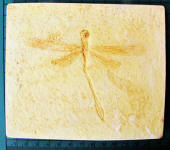 |
4. Dragonfly. Stenophlebia aequalis. Upper Jurassic,
145mya. From Bavaria. |
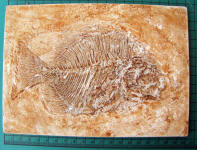 |
5. Fish. Archaephippus asper, a type of spadefish.
Eocene, 50mya. From Italy. |
 |
6. Compsognathus. A small dinosaur from the
Upper Jurassic, 150mya. From Solnhofen, Germany. A beautiful, complete skeleton. Although small, Compsognathus was a predator,
as we can see from its sharp teeth. |
 |
7. Shark tooth. Lamna otodus, Eocene, 55-45mya.
|
 |
8. Horseshoe (king) crab. Mesolimulus walchi. Upper
Jurassic, 140mya. Similar to modern horseshoe crab. From Solnhofen,
Germany. |
 |
9. Trilobites. Conocoryphe sulzeri. Middle Cambrian,
540mya. Very early and successful marine invertebrate; trilobites were
around for about 300 million years and developed into many different
forms. |
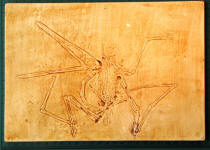 |
10. Pterodactyl. Pterodactylus antiquus. A flying
reptile, not a dinosaur but around at the same time. Upper Jurassic,
144mya. |
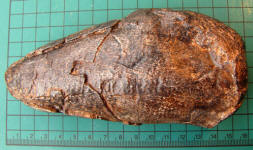 |
11. Egg of oviraptor. Dinosaurs laid eggs like modern
reptiles. Oviraptor means 'egg thief' - on first discovery of these eggs it was thought this
dinosaur was stealing another species' eggs, but it turned out the eggs
were her own. Late Cretaceous, 75mya. |
 |
12. Femur of ice age bison.
Bos species, from ice age,
30,000 years old. Found at Yarmouth, IOW.
|
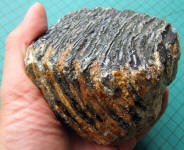 |
13. Woolly mammoth tooth. Mammuthus primigenius,
Pleistocene period, about 300,000 years ago. A juvenile molar, found in
the North Sea. Related to
the elephant, the mammoth developed fur to cope with the cold. Complete
specimens have been found frozen in the ice in Siberia. Hunted to
extinction about 11,000 years ago. |
 |
14. Tyrannosaurus rex claw.
Late Cretaceous, 65mya. T rex, like Triceratops, was one of the
last dinosaurs to live, before the mass extinction at the end of the
Cretaceous, caused by an asteroid collision.
. |
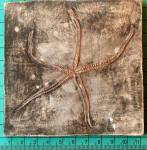 |
15. Starfish. Urasterella asperula, Lower Devonian,
410mya. Similar to modern brittle star. |
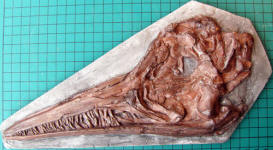 |
16.
Ichthyosaur skull. Predatory marine reptile similar
in shape to a dolphin. Jurassic, 200mya. From Lyme Regis. |
 |
17. Millipede. Xyloiulus sigillariae, Carboniferous,
320mya. About 60 body segments and 20 legs, 4mm long. |
 |
18. Frog. Propelodytes wagneri, not a true frog as it
dwelled in sand rather than water. Eocene, 50mya, from Germany. |
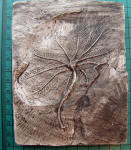 |
19. Crinoid. Hapalocrinus elegans, Lower Devonian,
400mya. A sea lily, a marine invertebrate with feather-like feeding
apparatus, still alive today. |
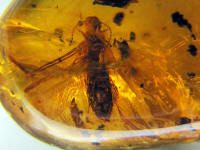 |
20. Termite. Miocene, 16mya. About 8mm long, in a piece
of amber from the Dominican Republic. Amber is tree sap which coats the
insect and preserves it perfectly. The wings and antennae of the termite
can clearly be seen. |
 |
21. Dinosaur footprint. Possibly Megalosaurus,
Jurassic, 150mya. From Buckinghamshire, UK. |
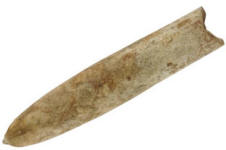
|
22. Belemnite. Part of a squid-like
animal, from Staithes, Yorkshire, 180mya. This is the 'guard', a hard
part inside the soft body of the animal. |
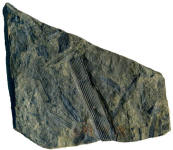 |
23. Horsetails, or calamites. An ancient plant still
alive today, although prehistoric species could grow as tall as trees.
Carboniferous, 315mya. Found at Newhey Quarry, near Rochdale, by me! |
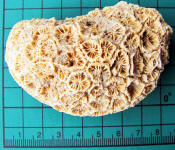 |
24. Coral. 1mya, Western Australia. |
 |
25. Sand dollar. Encope californicus, from Mexico.
Pliocene, 7mya. A form of sea urchin living in the sand, similar to
modern species. |
 |
Vertebra from an ichthyosaur. Found near
Whitby, UK. Jurassic, 200mya. |

























